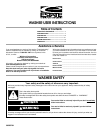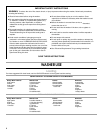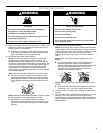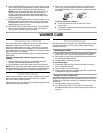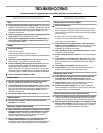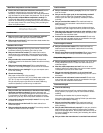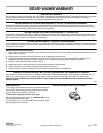
4
6.
Set the TEMPERATURE selector to the correct setting for the
type of fabric and soils being washed. Use the warmest wash
water safe for fabric. Follow garment label instructions.
NOTE:
In wash water temperatures colder than 70ºF (21ºC),
detergents do not dissolve well. Soils can be difficult to
remove. Some fabrics can retain wear wrinkles and have
increased pilling (the formation of small lint-like balls on the
surface of garments).
7.
(OPTIONAL) EXTRA RINSE selector (on some models). For an
additional rinse and spin at the end of a wash cycle, set the
EXTRA RINSE selector to ON. On some models, the EXTRA
RINSE feature is part of the cycle.
8.
(OPTIONAL) Some models have an END OF CYCLE SIGNAL
selector. Set this selector to ON if you want your washer to
alert you when the wash cycle is complete.
9.
Push in the Cycle Control knob and turn it clockwise to the
wash cycle you want. Reduce the wash time when using a
small load size setting. Pull out the Cycle Control knob to start
the washer.
To stop or restart your washer:
■
To stop the washer at any time, push in the Cycle
Control knob.
■
To restart the washer, close the lid (if open) and pull out the
Cycle Control knob.
WASHER CARE
Cleaning Your Washer
Use a soft, damp cloth or sponge to wipe up any spills such as
detergent or bleach from the outside of your washer.
Clean your washer interior by mixing 1 cup (250 mL) of chlorine
bleach and 2 cups (500 mL) of detergent. Pour this mixture into
your washer and run it through a complete cycle using hot water.
Repeat this process if necessary.
Remove any hard water deposits using only cleaners labeled as
washer safe.
Cleaning the liquid fabric softener dispenser (on some
models):
1.
Remove dispenser by grasping top with both hands and
squeezing, while pushing upward with thumbs.
2.
Rinse dispenser under a warm water faucet, then replace it.
NOTE:
If your model has a liquid fabric softener dispenser, do not
wash clothes with this dispenser removed. Do not add detergent
or bleach to this dispenser; it is for liquid fabric softener only.
Water Inlet Hoses
Replace inlet hoses after 5 years of use to reduce the risk of hose
failure. Periodically inspect and replace inlet hoses if bulges,
kinks, cuts, wear or leaks are found.
When replacing your inlet hoses, mark the date of replacement on
the label with a permanent marker.
Moving & Storage
Because some water may stay in the hoses, freezing can damage
your washer. If storing or moving your washer during freezing
weather, winterize it.
Winterizing your washer
1.
Shut off both water faucets. Disconnect and drain water inlet
hoses. Pour 1 qt (1 L) of R.V.-type antifreeze in the basket.
2.
Run washer on a drain and spin setting for about 30 seconds
to mix the antifreeze and water.
3.
Unplug washer or disconnect power.
To use washer again
1.
Flush water pipes and hoses. Reconnect water inlet hoses.
Turn on both water faucets.
2.
Plug in washer or reconnect power.
3.
Run the washer through a complete cycle with 1 cup (250 mL)
of detergent to clean out antifreeze.
Storage, non-use or vacation care
Operate your washer only when you are at home. If you will be on
vacation or not using your washer for an extended period of time,
you should:
1.
Unplug washer or disconnect power.
2.
Turn off the water supply to the washer. This helps avoid
accidental flooding (due to a water pressure surge) while you
are away.



